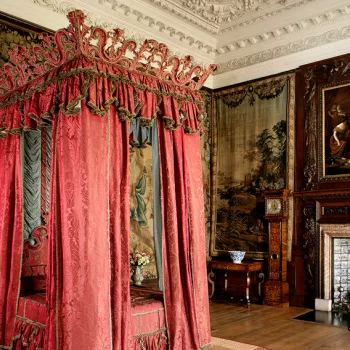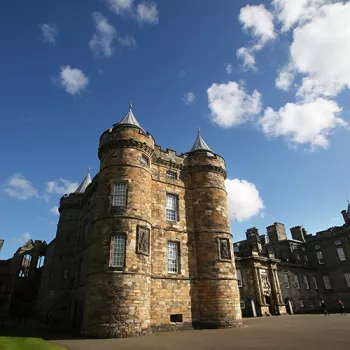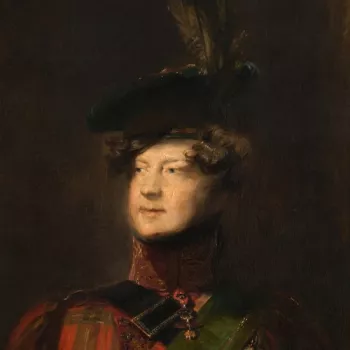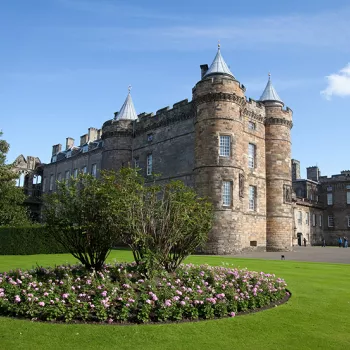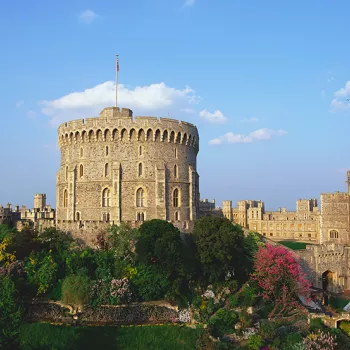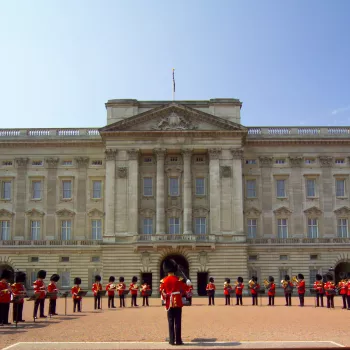Who built the Palace of Holyroodhouse?
Origins
According to medieval legend, the Abbey was founded around 900 years ago in 1128 by David I of Scotland. While out hunting, the king had a vision of a stag with a glowing cross between its antlers. Seeing this as a message from God, he had an abbey built on the very same spot. 'Holy Rood', the name of the Abbey, and subsequently the Palace, means ‘Holy Cross’.
We can never verify if David I did have a vision of a stag. But the history of the Palace of Holyroodhouse does lie in the creation of an Augustinian abbey in 1128 by David I. This church proved too small for the requirements of the community. Over 35 years from around 1195, extensive monastic buildings were added, including cloisters, a chapter house, a refectory and guest houses. The enlarged abbey prospered, and from an early date contained royal chambers for use by the sovereign.
Palace of Holyroodhouse | Mary, Queen of Scots, murder & betrayal | 900 years of royal history ©
James IV
It was James IV who decided to convert these royal chambers into a palace at the time of his marriage to Margaret Tudor, sister of Henry VIII of England in 1503. Although virtually nothing survives today of the early Palace buildings, it appears that they were laid out around a quadrangle. Main rooms, including the royal lodgings and the chapel were on the first floor, and a tower was added on the south side. Work also began on the Palace gardens, and in 1507 a loch beside the Abbey was drained.
James V
Work began in 1528 on a huge rectangular tower, rounded at the corners, to provide new royal lodgings at the north-west corner of the Palace. Equipped with a drawbridge and probably protected by a moat, the tower provided a high degree of security and is now the oldest part of the Palace surviving today (now available to visit as Mary Queen of Scots' Chambers). The west front of the Palace was rebuilt to house additional reception rooms. The elegant design incorporated a double-towered gateway, parapets and large windows. The south side was remodelled and included a new chapel.
James VI
During James VI’s reign from 1567, extensive repairs to the Palace were carried out, and the gardens were enlarged and improved. Further renovations were made after the King, who had succeeded to the English throne in 1603 as James I, returned to Edinburgh in 1617. The Palace and Abbey were further improved in 1633 for the Scottish coronation of James’s son, Charles I, which took place in the Abbey.
In 1650, after the Civil War and execution of Charles I, Parliamentarian soldiers arrived in Edinburgh with Oliver Cromwell. On 13 November, while Cromwell and his troops were stationed at the Palace, a devastating fire broke out, which destroyed large proportions of the apartments. After this, much of the Palace was abandoned, except for an area used as a barracks.
Charles II
When Charles II was restored to the throne in 1660, the city once again needed a magnificent palace to be at the heart of Scottish affairs – a place that would represent the monarch in Scotland’s capital and serve as the regular meeting place for the Scottish Privy Council. Between 1671 and 1679, Holyroodhouse was almost completely rebuilt. The designs for the Palace were approved by the king and paid for by the Scottish Privy Council. The newly rebuilt Palace glorified Scotland and emphasised Edinburgh's royal and government role.
The harmonious design of today’s Palace owes much to designer Sir William Bruce’s skill in blending old and new, and ensuring a smooth continuity with earlier buildings. The 16th-century north-west tower was balanced with a matching south-west tower, giving a symmetrical appearance to the new entrance front. The central doorway was bordered by giant columns framing the Royal Arms of Scotland. The existing plan, arranged around a courtyard, was retained.
Inside, the State Apartments were decorated with sumptuous plasterwork ceilings and elaborate wood carvings. The Great Gallery, the largest room in the Palace was hung with 111 portraits of the kings of Scotland painted by Dutch artist Jacob Jacobsz de Wet II.
By the end of 1674 the three main sides of the Palace and the new tower were virtually finished. Two years later the west front, which linked the towers, was completed. By 1679 the Palace had been re-constructed, largely as we see it today.
Queen Victoria
Improvements and renovations were carried out to the interior of the Palace for the visit of Queen Victoria in 1850. Prince Albert took a particular interest in the development of the immediate surroundings, and a new garden and stable buildings were created. A new fountain was installed in the forecourt, modelled on the Renaissance fountain at Linlithgow Palace, to the west of Edinburgh.
George V
From George V's reign in 1910 the Palace was modernised further with the installation of central heating, the modernisation of the kitchens, the addition of new bathrooms and the provision of a lift. The Palace was selected as the site of the Scottish National Memorial to King Edward VII and a statue of the king was placed facing the Abbey, on the forecourt which was enclosed with richly decorated wrought-iron railings and gates. As a result of these improvements the Palace was recognised as the official residence of the Sovereign in Scotland.
Queen Elizabeth II
During the reign of Queen Elizabeth II, the Palace was developed further to include a dedicated gallery space to show changing exhibitions of art from the Royal Collection, a new ticketing and welcome area, as well as a new public garden inspired by the earliest recorded gardens at the Palace. Further improvements were also made to visitor facilities.
As part of celebrations for Queen Elizabeth II’s Golden Jubilee in 2002, the new art gallery was inaugurated on 29 November by The late Queen, and opened to visitors the following day – St Andrew’s Day. The Queen’s Gallery features architectural details by contemporary artists, including sculptural bronze door handles by Jill Watson.
The Queen's Gallery has now become The King's Gallery.


